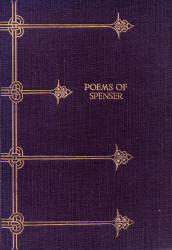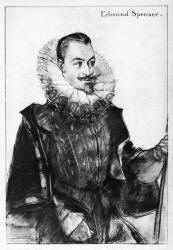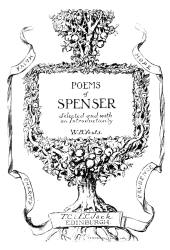I have put into this book only those
passages from Spenser that I want to remember and
carry about
with me. I have not tried to select what people call
characteristic passages, for
that is, I think, the way to make a
dull book. One never really knows anybody's taste but
one's own,
and if one likes anything sincerely one must be certain that
there are other
people made out of the same earth to like it
too.
I have taken out of the 'Shepherds
Calender' only those parts which are about love or
about old
age, and I have taken out of the 'Faerie Queen' passages about
shepherds and
lovers, and fauns and satyrs, and a few
allegorical processions. I find that though I love
symbolism,
which is often the only fitting speech for some mystery of
disembodied life, I
am for the most part bored by allegory,
which is made, as Blake says, 'by the daughters
of memory,' and
coldly, with no wizard frenzy.
The processions I have chosen are
either those, like the House of Mammon, that have
enough ancient
mythology, always an implicit symbolism, or, like the Cave of
Despair,
enough sheer passion to make one forget or forgive
their allegory, or else they are, like
that vision of Scudamour,
so visionary, so full of a sort of ghostly midnight animation,
that one is persuaded that they had some strange purpose and did
truly appear in just that
way to some mind worn out with war and
trouble. The vision of Scudamour is, I
sometimes think, the
finest invention in Spenser. Until quite lately I knew nothing
of
Spenser but the parts I had read as a boy. I did not know
that I had read so far as that
vision, but year after year this
thought would rise up before me coming from I knew not
where. I
would be alone perhaps in some old building, and I would think
suddenly 'out
of that door might come a procession of strange
people doing mysterious things with
tumult. They would walk over
the stone floor, then suddenly vanish, and everything
would
become silent again'. One I saw what is called, I think, a Board
School
continuation class play 'Hamlet'. There was no stage, but
they walked in procession into
the midst of a large room full of
visitors and of their friends. When they were walking in,
that
thought came to me again from I knew not where. I was alone in a
great church
watching ghostly kings and queens setting out upon
their unearthly business.
It was only last summer, when I read
the Fourth Book of the 'Faerie Queen', that I found
I had been
imagining over and over the enchanted persecution of Amoret.
I give too, in a section which I call
'Gardens of Delight', the good gardens of Adonis and
the bad
gardens of Phædria and Acrasia, which are mythological and
symbolical, but not
allegorical, and show, more particularly
those bad islands, his power of describing bodily
happiness and
bodily beauty at its greatest. He seemed always to feel through
the eyes,
imagining everything in pictures. Marlowe's 'Hero and
Leander' is more energetic in its
sensuality, more complicated
in it s intellectual energy than this languid story, which
pictures always a happiness that would perish if the desire to
which it offer so many roses
lost it indolence and its softness.
There is no passion in the please he has set amid perilous
seas,
for he would have us understand that there alone could the war-worn and the
sea-worn man find dateless leisure and unrepining peace.



.jpg)
.jpg)
.jpg)
.jpg)
.jpg)
.jpg)
.jpg)
.jpg)